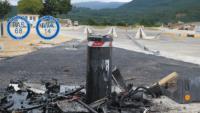 Add My Company
Add My Company
Sign In
Bollard Impact Resistance
25-06-2019

The importance of foundations
In recent years, security bollards have become increasingly newsworthy as a strategic security measure against the rise of terrorist and criminal activity. In light of recent world events, an important question that is asked of any type of bollards is what is it’s inherent stopping power and impact resistance, particularly when bollards are being considered for us on high security sites
With the growing use of bollards in the UK, and the increased need for their use as a strategic counter-terror measure, interest in the impact resistance and stopping power of the variety of bollards available on the market today. Engineering and physics both play a big part in determining just how much impact a bollard can take and disperse. What is an important factor to consider is that a bollard’s impact resistance has as much to do with the foundation installation, as with the bollard itself.
There are various types of bollards, that can be installed in a number of ways, with the two most common methods being surface mounted (bolted down) and rooted (foundation).
Surface Mounted Bollards
Surface mounted bollards include types such as low-impact fold down posts, flexible fixed bollards, removable posts, and decorative bollards. These types of bollard are usually fixed to a plate that is attached to the ground with bolts or concrete anchors. Whilst they do provide some very minor impact-protection, these types of bollard are mostly used for installations that provide traffic guidance (such as indicating a private parking spot) rather than as a security measure.
Rooted Bollards
Rooted bollards make use of a buried foundation, and include models such as fixed, manual telescopic and fully automatic retractable bollards. With these types of bollards, the focus is shifted more towards security and perimeter protection, and restricting vehicle access.
Not every rooted bollard gives a substantial level of impact protection. Some, like manual retractable and removable bollards, have an embedded foundation housing; when fully raised, these are similar to surface mounted bollards, with little to no substantial footing remaining. Bollards with deeply embedded foundations are the type that provide the higher level impact advantage. Their resistance is based on the security design and the part played by physics in the installation.
With certified impact tested bollards, such as those rated to IWA 14-1 and PAS 68 standards, the foundations make use of substantial rebar fortifications, enhancing the strength of the entire installation structure, to ensure a high level of vehicle impact resistance.
The most commonly recognised standards within the UK are:
PAS68 and IWA14-1
With both of these standards, the bollard installation requires considerable foundations, including rebar and specialist concrete, that ensure the integrity of the bollard strength and impact resistance of up to 50 mph. These standards require the bollards to undergo a crash test, and to withstand significant impact, so the foundation structure is key to the certification and to the continued use of the bollard system.
To discuss the range of options available, call us today on 0161 3206462 and we would be happy to assist you further.
For more information on Bollard Impact Resistance talk to Macs Automated Bollard Systems Ltd
Enquire Now
List your company on FindTheNeedle.

